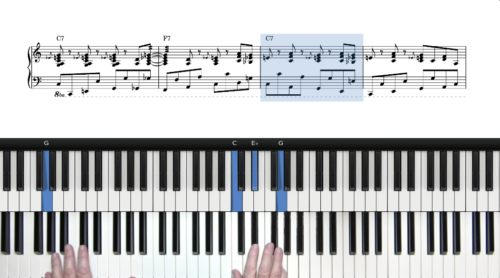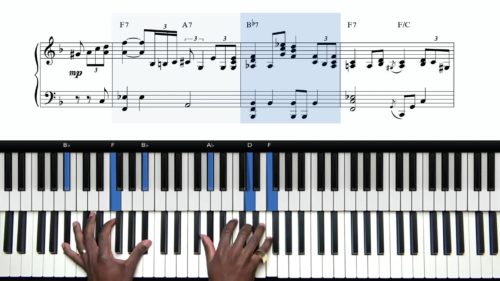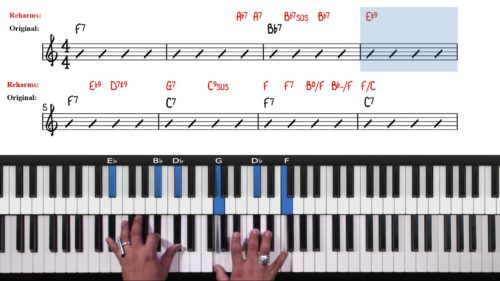Slow Blues Course Introduction
In this lesson we explore slow blues piano for beginners and beyond using the basic 12 bar blues in the key of F.
We start by discussing the foundational blues theory including the 12 bar form structure and the core pillars are the harmony. We first voice the chords with triads and then explore the 7ths chords, inversions, and isolating 3rds and 7ths in the right hand to create smooth voice leading.
How To Count The Slow Blues
We learn the best way to count the slow blues so that we stay in time and never lose the groove. Generally speaking, when we are playing the slow blues, the underlying pulse will be 12/8.
The easiest way to visualise the 12/8 meter is to divide each quarter note into 3 8th note triplets. We explore a number of drills to help internalise this rhythmic framework of the slow blues.
Voicing Techniques & Principles
We cover some important voicings techniques that help us to connect the chords smoothly and cleanly and create a synergy between our right hand voicings and our left hand bass line.
Towards the end of the lesson we introduce some more advanced concepts and harmonic ideas such as leading tones, passing chords, chord alterations, walk-ups, walk-downs, and options for the turnaround at the end of the tune.
Lesson Downloads
-
Slow Blues Chord Changes File Type: pdf
-
Opening Performance Transcription File Type: pdf
Practice Tips
-
The first step to playing slow blues is to memorise and internalise the 12 bar form so that we don't have to think about what chord is coming next. The basic 12 bar form only includes 3 chords; the I7, IV7, and V7 chords.
-
Outline the 12/8 pulse with 3rds & 7ths in right hand over the single bass note in the left hand. Next isolate the 12/8 pulse exclusively in the left hand using the simple bass line.
-
Once the left hand bass line is comfortable and confident, it's time to introduce simple melodic ideas into the right hand to develop our hand independence.
-
When you can play through the basic changes without mistakes you are then ready to introduce more sophisticated harmonies such as passing chords, chord alterations, leading tones, walk ups, walk downs, and turnaround passages.









A great lesson. Some nice examples of making the blues progression more interesting. I really enjoyed the advanced techniques section.
Thanks for the feedback Dean – I’m glad you enjoyed the lesson.
I’m creating a series of lessons on intermediate/advanced techniques which we can apply over the basic 12 bar blues changes.
More updates to follow!
Cheers,
Hayden
I second Dean’s message. Really helps outline the blues basics as a foundation and then bridge to the other blues lessons and courses. I hope you keep expanding this course. I like the new openings and the graphics showing notation to explain concepts.
Thanks Rick – yes I am working on a full course which builds upon the foundations covered in this lesson.
As an example, in the next lesson we cover a bluesy 1625 turnaround which we can use in bars 11 and 12 of the 12 bar blues in F. You can find that here: pianogroove.com/blues-piano-lessons/soulful-blues-chord-voicings/
There is a bit of a jump here from the basic R-3-5-7 voicings that we use for the majority of this lesson, but hopefully you can see that once we can play a basic blues with a steady pulse and groove, we can then add more sophisticated harmonies.
Talk soon, cheers,
Hayden
I really like this tutorial, combining something that sounds good, that I want to play, with all of the explanations is perfect.
I haven’t focused much on dynamics but found this to be muddy when playing both hands at the same volume. The transitions from the uh, filler IV triad (?) to the root triad on each chord was too noisy without easing off a lot on the left hand. Interesting to see a tune where that kind of thing makes a big difference, good practice.
Thanks for the feedback Sam – I’m glad you’re enjoying the material.
Interesting point with the bass line volume and the ‘IV Filler Triad’ – I actually dialled up the bass volume in my recording of this lesson as sometimes the bass is too quiet when I record with Logic.
I find that the bass line grace note adds a lot of impact to the ‘IV Filler Triad’ – I mention this at 24m42s.
My view is that it’s best to ‘follow your ears’ on what sounds best to you, both in terms of the voicings/fills that you use, and also dynamics such as volume and accents. That way you will start to develop your own sound and style when playing the blues.
Talk soon, cheers,
Hayden
ps. the developer looked into the progress bar issue that you mentioned and he said he couldn’t find any problems. Please let me know if you are still experiencing issues.
Hey Hayden, I think the dynamics problem is that I’ve not paid much attention to varying volume at all so the chords sometimes overpower the melody when I play. Agreed, that grace note needs emphasis, it’s the root and 7 going back to the I chord after it that sound too loud the way I play it, on my piano at least… Like you say, listen and adjust!
that was a really great lesson…well done sir…!!!
Thanks Michael – I think you will also love the rest of this course.
Lessons 1, 2, and 3 are the same material as the course overview video, but split into shorter, more actionable lessons.
Once you have a good understanding of the basics covered in this lesson, get started with the module on “Turnarounds”.
The final module on improvisation will be added to this course later this month so more lessons to come.
Talk soon,
Hayden
Hey Hayden, could you please elaborate on the fingering of the left hand when you use grace notes in the basic pulse e.g. at around 24’30”?
Hi Franz,
Sorry for the late reply here.
Yes any time that I play a grace note in the left hand bass line, it’s my left hand index finger ‘flicking’ into my left hand thumb. The key to this technique is to play the left hand ‘flick’ or ‘grace note’ immediately before the right hand plays the inverted Bb Major triad.
The left hand grace note is the note ‘C’ which I am playing with my index finger, and this is played momentarily before the note ‘D’ which I am playing with my thumb. The note ‘D’ in my left hand is played in unison with the right hand triad.
I am hosting a seminar on slow blues on the 24th January, and I have made a note to demonstrate and discuss this concept as it’s an important part of the slow blues. You can add the seminar to your calendar here: pianogroove.com/live-seminars/slow-blues-drown-in-my-own-tears/
In the seminar we explore the slow blues tune “Drown In My Own Tears” and we will demonstrate this exact technique over the C7, F7, and F#dim7.
Please let me know if that helps and if you have any further questions here.
Talk soon,
Hayden
p.s. The final 2 improvisation lessons will be added to this course today.
Really good job Hayden!
The course looks very promising and exciting. I think it’s cool that you always add some small pro tips that gradually makes it sound better and keep students more motivated to practice.
I have only two questions.
The approach that I was thinking to follow is to try transposing in different keys as well at the end of each lesson but I’m struggling a bit.
I believe there should be some tricks to have the same sound also with different keys, trying to keep the same register. Or maybe it’s about inversions and slightly different voicings?
The second thing I wanted to ask is if there’s any cool backing tracks recommended to practice slow blues?
I saw there are some resources on iReal Pro and YouTube as well. There’s also a blues style package for iReal Pro that sounds better but it’s not free. Wondering if it’s worth buying it.
Thank you and best regards!
Hi Paul 👋
I’m glad that you are enjoying the course.
Yes indeed transposition is important to really ingrain a melodic idea, fill, chord voicing, lick etc… in our mind and our muscle memory. Next Wednesday I’m hosting a slow blues seminar on the tune “Drown In My Own Tears” which is in the key of C and we will apply material from this course, and vice-versa, and i will explain the process of transposition for blues material, and challenges with different keys/registers.
You can add the seminar to your calendar here: pianogroove.com/live-seminars/slow-blues-drown-in-my-own-tears/
Regarding inversions and slightly different voicings, yes this is also important, as you progress through this course you will encounter drills and exercises to explore the different registers of the piano when playing slow blues.
Finally, yes for a backing track for slow blues, there is a cool little app called “DrumGenius” which is available on the App Store and the Android Store. The app icon is a man with a green face. When you download the app I believe you get a few credits for free, and so check out the category “Jazz – New Orleans & Traditional” and then select the backing track “Gospel 12/8”. That one works quite nicely for the slow blues. The nice thing with DrumGenius App is that there is no bass lines – just the drums – which works perfectly playing this style of blues where we are playing the bass line. Also the drum sounds in DrumGenius are much more realistic and authentic than iRealPro.
Here is a forum post with links to the app: community.pianogroove.com/t/drumgenius-best-metronome-practice-app-ever/3308
I’ve also made a note to cover drum backing tracks in my seminar next week and I’ll do a little more research in the interim to find the best backing tracks for this course.
I hope that helps Paul and let me know if you have any other questions.
Talk soon,
Hayden
Thank you Hayden, that’s really perfect!
Looking forward to join the live seminar and I will try also the app you suggested for backing tracks. 🙂
Hey Hayden- great course so far but quick question I think I already know the answer to but are you using and pedal during this?
Hi Leo,
Yes I use the pedal when playing this style.
Make sure you lift the pedal when you change chords so that you don’t blur the harmonies together.
When playing this style we can use lots of pedal and it works well to create interesting ‘overhanging tones’ and dissonance, but of course use your judgement on how much pedal is enough and how much is too much.
It takes some experimentation to get it just right, as a rule of thumb, always lift the pedal quickly when you change chords to keep it sounding clean and crisp.
Let me know if you have any further questions here.
Talk soon,
Hayden
Hi Hayden –
Great content and organization in this slow blues course. I have a question regarding Voicings. I’m very comfortable playing a voicing when a melody note already exists. I understand the mechanics of Building voicing’s beneath, etc. But when presented with Voicings on your own I am always confused about which melody note to choose. For example when you do the turnaround you present different progressions. Taken on your own, how would I know whether to start with the root on top, flat seven on top, third on top, etc.? I think a lesson or module on this topic would be really helpful , thank you.
Hi Ron,
Great question!
It really depends on the type of turnaround being used. Here are some general rules to follow:
Using The 1 Chord Root As A ‘Drone Note’
First I recommend to practice the turnaround phrases that keep the root of the 1 chord as the melody note throughout the turnaround. We are playing blues in F and so the root of the 1 chord is “F” and we keep this note on top throughout the turnaround. This creates a ‘drone note’ which stays consistent through the other chords. This works with the basic blues turnarounds that we cover in the first lesson in the turnarounds module. The important thing to see here is that the note “F” is a primary chord tone in all of the chords in the basic turnaround (F, F/A, Bb triad, Bbdim7, and F/C) which leads onto the next point:
Using Chord Tones In The Melody
If you look at the gospel turnaround lesson you will see that the melody, or the top note, is always a chord tone of the underlying chord. For F7 we use the root of the chord in the melody, for A7 we use the 5th of the chord, for D- we use the 3rd, for G7 we use the 7, and for C9sus we use the 4 (which is also the root of the 1 chord). The primary chord tones (roots, 3rds, 5ths, and 7ths) are the most stable melody notes to use as we are playing directly within the harmony. I recommend to copy and memorise the demonstrations in this lesson which will allow you to see how the primary chord tones are being used to create a stable melody which is perfectly ‘in sync’ with the underlying harmony.
More Elaborate Turnarounds
We also cover New Orleans Style Turnarounds in the turnaround module where we use the 1-6-2-5 progression. I recommend to learn this progression separately, as covered in this lesson and transpose the movement into 2 or 3 keys such as C, F, and G. The difference here is that we introduce the 9th in the melody over the 2 chord (played either as a dominant 9, or minor 9 chord) which you should hear adds more richness than sticking to the chord tones as shown in the gospel turnaround lesson.
In Summary:
In summary there are many variables depending on which type of turnaround we choose to play. The turnarounds covered in this course are not a exhaustive list, but just some important and common turnarounds to learn as a starting point. There are no ‘set in stone’ rules to follow but the above should give you some ideas, and particularly understand the role of chord tones in the melody vs. chord extensions such as 9ths and the different sound this creates.
Yes great idea. I am creating a new slow blues series in the key of C for which the first lessons will be ready in a week or so, and I have added a lesson on exactly this topic… “melody notes in turnarounds”. I will explain the above in more detail with examples.
In the interim, please check out the lessons in the Turnaround module and emulate the demonstrations. The turnaround module shows these different styles of turnarounds starting with basic and moving to sophisticated. Simply learn the examples note-for-note and try to mix and match them as you circle around the blues (ie. don’t play the same one every time).
Look out for the new slow blues in C lessons coming shortly.
Talk soon,
Hayden
Wow – your response really set a lightbulb off in me, as I now have a better understanding of how and where to place a melody note for a given progression. The “Drone Note” is a great way of thinking about it, with the understanding that occasionally one must deviate the melody note to fit the adjacent chord. Kind of made me think the concept of using a pedal tone in the bass.
I’m really pleased that you are planning an enhanced lesson on this melody note concept. Really looking forward.
Thank you for your comprehensive and enlightening response.
Ron